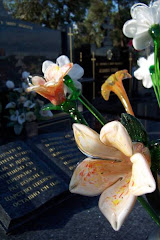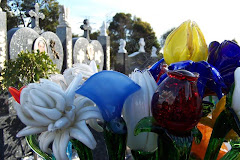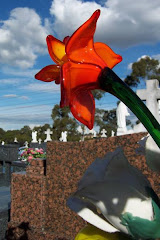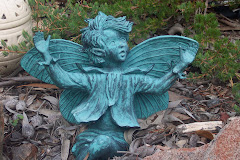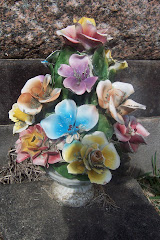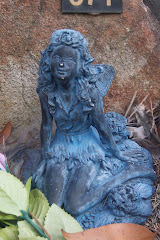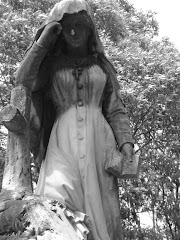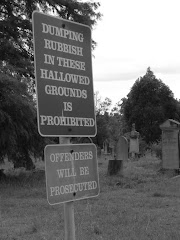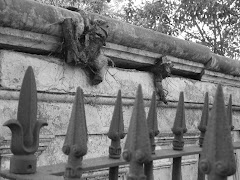Death - The Last Taboo
Throughout the world, death and the rituals that surround it are steeped in taboos. Death is celebrated, embraced and feared. Around death and the dead, cultures put in place diverse restrictions and practices associated with clothing, food and ritual. This section of the Australian Museum website explores what happens to us when we die and the different ways we deal with death.
Friday, November 20, 2009
Monday, October 26, 2009
What we leave with the dead and why....and more
Podcast from Thinking Allowed (BBC)
Laurie Taylor finds out about what we leave with the dead and why.
"From clothes to jewellery, photographs, hats, eye glasses, walking sticks, letters and even food, alcohol and tobacco, the objects mourners leave in the coffins and caskets of their loved ones tells us a huge amount about our attitudes to death and the rituals it involves.
Laurie talks to Sheila Harper, sociologist at the Centre for Death and Society at the University of Bath, whose new study about 'modern-day grave goods' uncovers the fascinating, touching and often moving examples of our gifts to the dead and why the objects we leave today are remarkably similar to the kinds of items uncovered by archaeologists in graves going back thousand of years.
Duncan Sayer, archaeologist from the Centre for Death and Society, discusses how human society has buried their dead.
Sheila Harper is an associate at the Centre for Death and Society at the University of Bath. Her PhD research focused on how mourners view the recently dead (in funeral establishments) and the ancient dead (in museums) in England and the United States. Sheila is also the Editorial Assistant for Mortality.
Paper: ‘I’m Glad She Has Her Glasses On. That Really Makes the Difference’ Grave Goods and Identity
By Sheila Harper
Duncan Sayer has PhD in Archaeology from the University of Reading. He has been a visiting lecturer at the Universities of Reading and Chester and is currently an associate lecturer at the University of Bath’s Centre for Death and Society."
Mortuary Practice and Social Identities in the Middle Ages
Sayer, D & Williams, H. (eds)
Publisher: University of Exeter Press
ISBN-10: 0859898318
ISBN-13: 978-0859898317
Have a listen
Laurie Taylor finds out about what we leave with the dead and why.
"From clothes to jewellery, photographs, hats, eye glasses, walking sticks, letters and even food, alcohol and tobacco, the objects mourners leave in the coffins and caskets of their loved ones tells us a huge amount about our attitudes to death and the rituals it involves.
Laurie talks to Sheila Harper, sociologist at the Centre for Death and Society at the University of Bath, whose new study about 'modern-day grave goods' uncovers the fascinating, touching and often moving examples of our gifts to the dead and why the objects we leave today are remarkably similar to the kinds of items uncovered by archaeologists in graves going back thousand of years.
Duncan Sayer, archaeologist from the Centre for Death and Society, discusses how human society has buried their dead.
Sheila Harper is an associate at the Centre for Death and Society at the University of Bath. Her PhD research focused on how mourners view the recently dead (in funeral establishments) and the ancient dead (in museums) in England and the United States. Sheila is also the Editorial Assistant for Mortality.
Paper: ‘I’m Glad She Has Her Glasses On. That Really Makes the Difference’ Grave Goods and Identity
By Sheila Harper
Duncan Sayer has PhD in Archaeology from the University of Reading. He has been a visiting lecturer at the Universities of Reading and Chester and is currently an associate lecturer at the University of Bath’s Centre for Death and Society."
Mortuary Practice and Social Identities in the Middle Ages
Sayer, D & Williams, H. (eds)
Publisher: University of Exeter Press
ISBN-10: 0859898318
ISBN-13: 978-0859898317
Have a listen
Thursday, July 23, 2009
Glass Flower Collection
On my recent (re)visit to Rookwood Cemetery I noted in the Macedonian section of the park a recurring them in terms of flora decoration. The glass flowers came in all shapes, sizes and colours and were particularly beautiful additions to the plots. I took a number of pictures of these which can be seen either in the picture gallery on the right or at here.
New additions








News
I have added some new (old) pictures to the photographic collection including Belgrade New Cemetery and some new photographs from my recent return visit to Rookwood Cemetery.
Recent Visits
Today I went out to revisit Waverley Cemetery and found some really amazing statues, headstones and inscriptions. See my selection below - the full photographic collection will go up as soon as my partner processes them!
Sunday, May 10, 2009
Pinegrove Memorial Park





On the last day of the school holidays I decided to stop programming lessons for Term 2 and go out to take some more photographs. The journey to PineGrove Memorial Park took about 45 minutes on the way there, and about 75 on the way back (did not think of peak hour traffic!). It was a rather strange experience as it is a relatively new cemetery and has large tracks of unused land. The design is interesting, especially the specially designed Asian burial grounds completed with Lion gates. It is not as inviting as other cemeteries however, perhaps because it is so new and rather 'artificial' in its presentation and variety of memorials..
I have included a selection of photographs from the day here, and have added the rest to the photographic collection (see navigation bar). they turned out better than I expected. I think this might have had something to do with the light - a cold day with bright light. Most of the pictures were taken between 3pm and 4.30pm.
Ps. I have uploaded the rest of the cemetery photographs from Canberra and other Sydney locations as well, finally.
Monday, April 27, 2009
Woden Cemetery






On a recent trip to Canberra, we visited Woden Cemetery. See this map for the exact location. It is a rather beautifully set out cemetery, fan like in its layout.
History
"Opened in 1936 and closed in 1979. The Cemetery was re-opened in March 1999. This formally planned cemetery features many stately mature trees and offers lawn and monumental burial sites in different religious and general areas." Source
and this....
"Woden Cemetery was Canberra's first public cemetery, opening in January 1936 as a denominational cemetery. The plan included the provision of areas for special buildings at a later date and the cemetery was designed to both reflect our heritage and allow for future enhancement of the landscaped gardens. It is a formally planned, open park style cemetery with many stately mature trees and lawn and monumental burial sites in different religious and general areas.
Woden Cemetery was closed in August 1979 except for burials for which reservations are held. The cemetery was re-opened in March 1999. In 1992 Memorial Gardens for interment of ashes and an ex-Service section were added. An enclosed mausoleum, called Christ the Redeemer Mausoleum, for burial in 304 above ground vaults was completed in 2001.
A Garden of Remembrance opened in 2005, for official commemoration of war veterans where it cannot be provided at the gravesite or crematorium. In a uniquely Australian concept, eligible war veterans are permanently commemorated using individual bronze plaques mounted on walls in a landscaped garden. Previously, most of the veterans from the ACT and surrounding districts were commemorated at the NSW Garden of Remembrance in Rookwood, Sydney, but the majority of those plaques have now been transferred to Canberra. The Garden also features a visitor pavilion, seating and symbolic artwork.
While the majority of burials are of Canberrans, ashes and memorial plaques represent people from as far south as Eden and as far north as Goulburn.,Woden Cemetery forms part of the Woden Town Park." Source
I have included a selection of photographs but more will be available when we can get around to uploading this and two other collections - Liverpool General Cemetery and St Peters Anglican Church cemetery. When these are online I will include a short piece on each.
Labels:
cemeteries,
garden of remembrance,
veterans,
woden cemetery
Subscribe to:
Comments (Atom)



